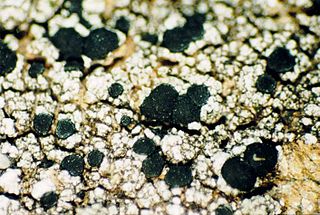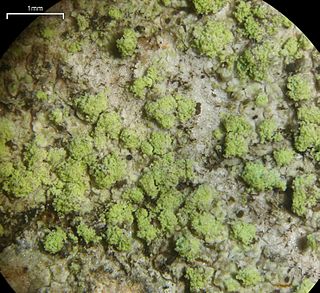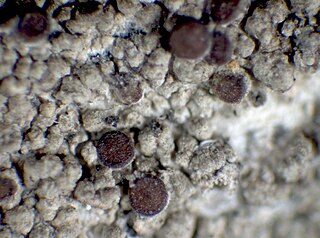
The Lecanoraceae are a family of lichenized fungi in the order Lecanorales. Species of this family have a widespread distribution.

Biatora is a genus of lichens in the family Ramalinaceae. First described in 1817, the genus consists of crustose and squamulose lichens with green algal photobionts, biatorine apothecia, colorless, simple to 3-septate ascospores, and bacilliform pycnospores. According to the Dictionary of the Fungi, the genus contains 42 species that are widely distributed in temperate areas.
Japewiella is a genus of lichen in the family Lecanoraceae. It was circumscribed in 2000 by German botanist and lichenologist Christian Printzen as a segregate of the genus Japewia. The genus name of Japewia was in honour of Peter Wilfrid James, who was an English botanist. The genus was circumscribed by Christian Printzen in Bryologist vol.102 on page 715 in 1999.

Mycobilimbia is a genus of lichen-forming fungi in the family Ramalinaceae.
Biatora epirotica is a species of corticolous (bark-dwelling) lichen in the family Ramalinaceae. Found in specific regions of the Balkans and Turkey, it was described as new to science in 2011 by lichenologists Christian Printzen and Toby Spribille.
Biatora aureolepra is a species of lichen in the family Ramalinaceae, first found in inland rainforests of British Columbia.
Biatora ligni-mollis is a species of lichen in the family Ramalinaceae, first found in inland rainforests of British Columbia.

Hertelidea is a genus of crustose lichens in the family Stereocaulaceae. Characteristics of the genus include carbon-black ring or outer margin (exciple) around the fruit body disc (apothecium), eight-spored, Micarea-type asci and mostly simple, hyaline ascospores that lack a transparent outer layer. Hertelidea species mostly grow on wood, although less frequently they are found on bark or soil. While the type species, Hertelidea botryosa, has a widespread distribution, most of the other species are found only in Australia.
Coppinsidea vainioana is a species of crustose lichen in the family Ramalinaceae. It occurs in Europe, where it grows on the bark of pine trees.
Biatora oxneri is a species of corticolous (bark-dwelling) lichen in the family Ramalinaceae. It is found in the Russian Far East and in South Korea.
Biatora pacifica is a species of corticolous (bark-dwelling), crustose lichen in the family Ramalinaceae. It is found in Russia, Japan, and South Korea, where it grows along the Pacific coast. It inhabits the bark of a variety of coniferous and deciduous plants.
Biatora radicicola is a species of corticolous (bark-dwelling) and saxicolous (rock-dwelling), crustose lichen in the family Ramalinaceae. It is found in various locations in Europe, where it grows in sheltered and humid microhabitats, often on exposed root bark at the base of trees.
Hannes Hertel is a German lichenologist and taxonomist and was Director of the State Herbarium in Munich, Germany 1992–2004. His specialist areas are the fungi and lichens.

Biatora pontica is a species of corticolous (bark-dwelling), leprose lichen in the family Ramalinaceae. It is a widely distributed species, having been recorded in Africa, Asia, Europe, and North America.

Myochroidea is a genus of lichen-forming fungi of uncertain familial placement in the order Lecanorales. It has four species of grey or brown-grey crustose lichens.

Tor Tønsberg is a Norwegian lichenologist who has made significant contributions to the taxonomy, chemistry, floristics, and phytogeography of lichens and lichenicolous fungi. Throughout his career, he has described more than one hundred species and genera new to science, advancing the knowledge of lichens in Europe and North America.
Biatora toensbergii is a species of corticolous (bark-dwelling), crustose lichen in the family Ramalinaceae. It is found in Norway and northwestern North America.
Biatora bacidioides is a species of corticolous (bark-dwelling), leprose lichen in the family Ramalinaceae. It was formally described as a new species in 2003 by the lichenologists Christian Printzen and Tor Tønsberg, from specimens collected from Picea orientalis forests of north-eastern Turkey. It was recorded from Ukraine in 2018.
Biatora chrysanthoides is a species of corticolous (bark-dwelling), leprose lichen in the family Ramalinaceae. It is found in Norway, the Pacific Northwest of northern North America, Sweden, and Russia. It was formally described as a new species in 2003 by the lichenologists Christian Printzen and Tor Tønsberg. It contains gyrophoric acid in both the thallus and the apothecia, resulting in a C+ chemical spot test reaction. Its ascospores are 9.3–10.7 by 3.2–3.3 μm.
Biatora pausiaca is a species of corticolous (bark-dwelling), leprose lichen in the family Ramalinaceae. Found in the United States, it was formally described as a new species in 2003 by the lichenologists Christian Printzen and Tor Tønsberg. Its ascospores are 3.5–6.5 μm wide, and it does not contain any lichen products detectable with thin-layer chromatography. It is closely related to Biatora vezdana; these two species form a clade that itself has a sister relationship with Biatora radicicola.






